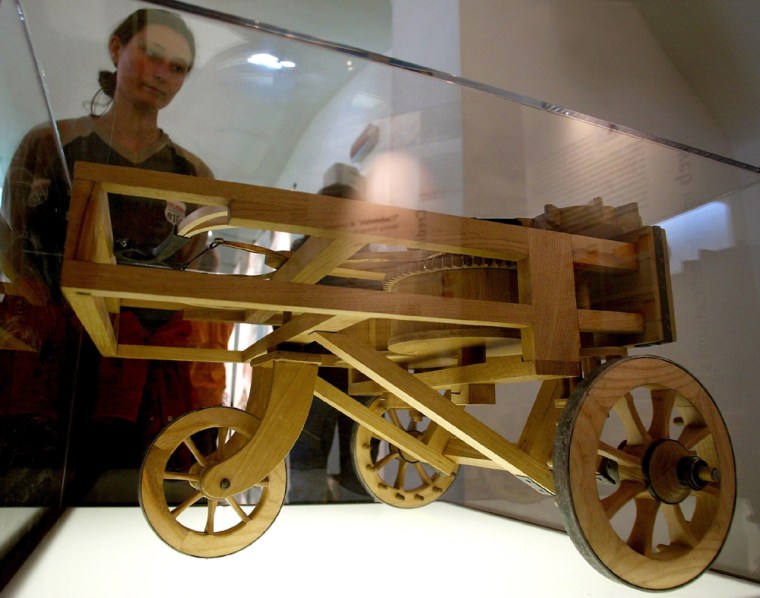Many small towns have native sons or daughters who hit the big time after they got the itch and left.
But there is only one that can claim to have given humanity perhaps the most towering creative genius who ever lived.
Welcome to Vinci. Birthplace of Leonardo, as in the one and only Leonardo da Vinci — painter, sculptor, architect, musician, engineer, inventor, scientist, military strategist, botanist, anatomist and doodler.
No one else from Vinci ever became famous, but then again, how many world-class geniuses can a town of 14,000 handle?
Museum hits the big time
This sleepy Tuscan hill town just north of Florence is celebrating da Vinci with a expansion of its Leonardiano Museum.
But you won’t see the Mona Lisa here, not even a copy.
The museum is heaven on earth not just for thinkers but for tinkerers, a shrine to the first high priest of do-it-yourself.
It is home to gadgets of greatness that the Renaissance master, who lived from 1452 to 1519, designed in his sketchbooks but were not or could not be constructed for centuries.
And the main attraction these days is Leonardo’s automobile. That’s right, an automobile. It’s concept is believed to be history’s first for a self-propelled vehicle.
Leonardo drew the vehicle in about 1478, 431 years before Henry Ford’s Model T rolled off the assembly line in a place called Detroit on a continent that Columbus had yet to discover.
“As Leonardo became older, he dedicated more time to mechanical sketches and doodles than to art,” Romano Nanni, the museum’s director, said matter of factly.
Doodles of brilliance
Given his daily proximity to genius, Nanni can be forgiven his understatement.
Leonardo also “doodled” a helicopter, a submarine, a tank, a robot, a parachute, a suspension bridge, a mechanical calculator and many other inventions that did not see the light of day until centuries later.
On a recent sweltering day, Nanni, along with Vinci’s mayor Dario Parrini and a host of workers, were scrambling to get the new pavilion ready for its opening night.
The car, unveiled earlier this year in Florence, is the star.
It looks like a cross between a Western wagon with no cover, the innards of a giant wristwatch and a cannon cart — with a dash of a lunar rover module thrown in.
You would have a hard time imagining some Renaissance-era Marcello Mastroianni trying to impress a Tuscan beauty on the streets of 15th-century Florence with it.
But historians suspect that Leonardo did design it to impress someone important.
“We think Leonardo probably designed it to move according to a pre-set course at a royal court, perhaps to cause a sensation for a visiting king from outside Italy,” Nanni said.
Girolamo Calvi, an Italian academic and trailblazer in modern Da Vinci studies, discovered the drawings of the vehicle in 1905 on page 812 R of the Codex Atlanticus.
How was it propelled?
For decades, scholars and engineers theorized about how the car might work and built several models. But each begged the question of what propelled it.
Earlier models that were based on assumptions that it was propelled by leaf springs only fueled more frustration. The leaf springs turned out to be part of the steering system.
It was not until about 1975 that Italian Professor Carlo Pedretti deduced that sketches of coiled springs in other parts of the codex may have been intended for the automobile.
He determined that da Vinci planned to put the springs in two closed wooden drums underneath the surface of the automobile. When wound, the springs transmitted energy to the wheels via a complex series of wooden gears and steel plates.
He teamed up with American robotics expert Mark Rosheim to create the model, built by a team headed by Paolo Galluzzi at Florence’s Institute and Museum of History and Science.
But wait ... there's more
The museum is a fitting garage for the wheels of the man who painted for popes in his spare time, but it holds much more that can get today’s mechanical dreamers cranked up with inspiration.
Its new extension also includes a machine called the “goldbeater,” which da Vinci designed to make gold leaf or thread for brocades or to decorate ornate picture frames.
A bar of gold about 4 inches (10 centimeters) high and 13 inches (32 centimeters) long is placed under a protective sheath of leather while a heavy iron weight controlled by gears pounds it rhythmically from left to right. The basic concept is still used in machines today.
“Because the drawing of the ’goldbeater’ appears often in the codex, we suspect that Florentine jewelers may have commissioned Leonardo to dream up a machine to make their work easier,” said Rosi Fontana, a spokeswoman for the museum.
“Those were economic boom times in the Florence area and everyone seemed to want a brocade or gold leaf, just like when in the 1950s everyone wanted a refrigerator,” she said.
Da Vinci did not foresee the refrigerator. But he did tinker with the concept of solar energy to heat water with mirrors. It is another of his doodles.
